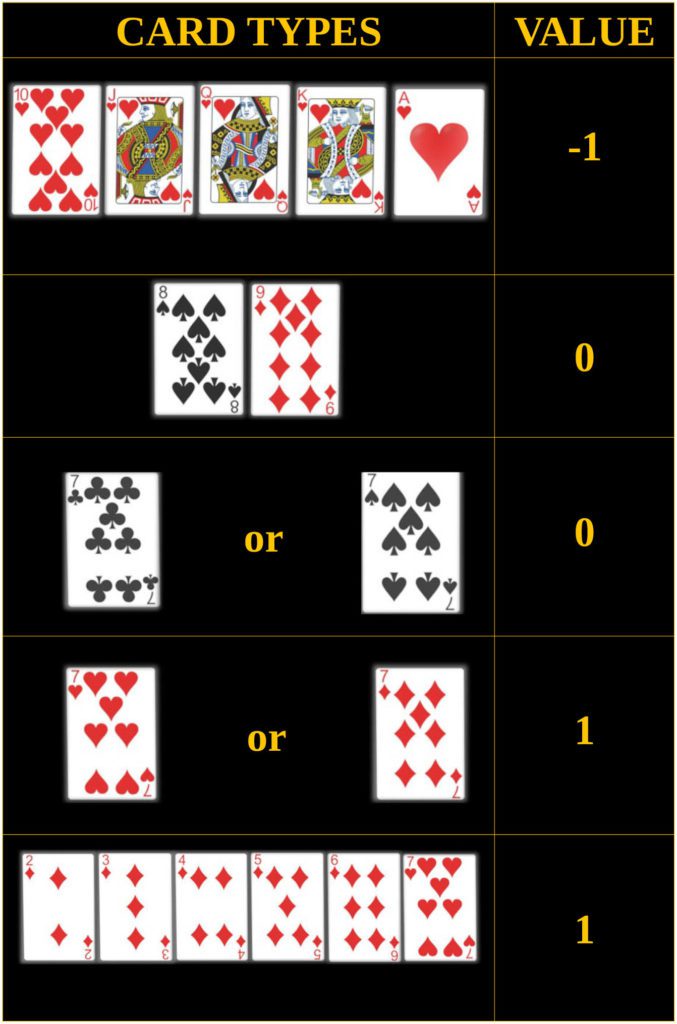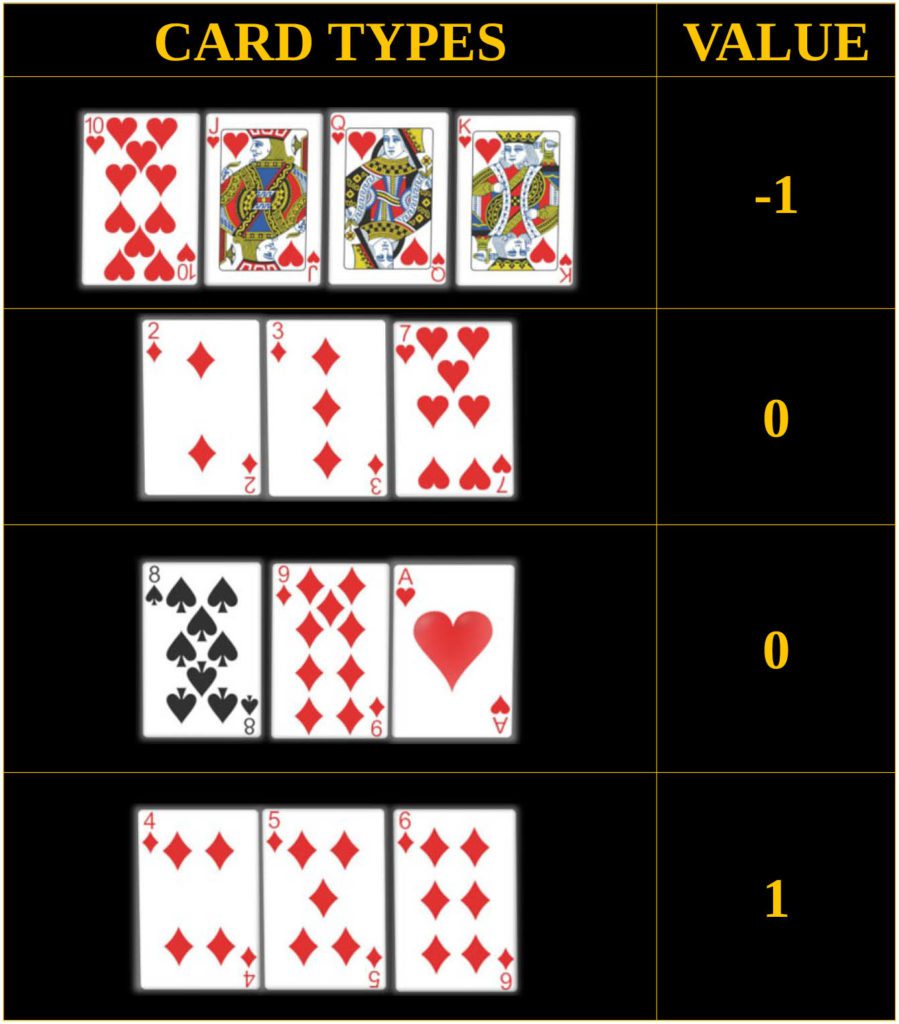
Card counting systems differ from most of the other betting systems because counting cards works in the long run. All of card counting is based on the skill of tracking the ratio of high to low cards.
In real money games, card counting allows you to increase your bets at the proper time and reduce your losses during cold streaks.
A few critical considerations should be made before using the card counting strategy:
- The number of decks involved in the game – This is important because the strategy’s basic principle is predicated on the likelihood of what cards will appear next.
- The ratio of strong and weak cards – The reason for this is that it gives you a solid indication of whether you are more likely to draw a high-value card or a low-value card.
- Be familiar with the basic strategy first.
Benefits of Card Counting Systems
Card counting methods allow you to adjust your basic strategy as needed, allowing you to make better decisions about your bets and movements. By changing your wagers in the most effective method, you can dramatically reduce your money losses using card counting systems.
You can use card counting system to make decisions whether to increase or decrease your bets based on the information provided by the cards on the table, thereby preventing you from losing money.
How Card Counting Systems works?
Card counting works because the rules are set in such a way:
- The player has an advantage when the remaining cards in the show or deck have more high cards than low cards.
- The casino has the advantage when the high and low cards have an identical ratio and the remaining cards are more high than low.
Card counting involves keeping track of the low and high card ratios when cards are played. You bet more money when you see that the deck or shoe gives you an advantage. If you constantly bet the same amount of money, the modest advantage you have in these scenarios isn’t enough to compensate for the casino’s advantage in all other situations.
This is why the majority of blackjack players are losing money. However, if you bet more money when you have an advantage than when you don’t, you can win enough to cover all of your losses on smaller wagers.
Advantages and disadvantages of Card Counting
Advantages of Card Counting Systems
One of the most significant benefits of the card counting system is that it allows players to totally eliminate the house edge and acquire a long-term advantage. However, this can only be done if they are exceptional card counter who have developed the necessary concentration and discipline.
Players can also gain from it since it allows them to make long-term profits by adjusting their bets based on the remaining cards in the deck.
The notion that card counting can only be mastered by persons with strong mathematical ability is incorrect.
Disadvantages of Card Counting Systems
The main disadvantage of Card counting system is that it requires extreme focus and concentration, which can be difficult for players to achieve in a casino.
The discipline plays a crucial role. Card counting allows players to make adjustments to their decisions based on the information provided by the cards. However, this can be a double-edged sword. The reason for this is that other elements, such as feelings or background, may impact a decision at the time.
Perhaps the most significant disadvantage of card counting is that many casinos are reluctant to have players who use it because it provides them with a significant edge when used correctly.
Popular Card Counting Systems
There are several card counting systems out with varying degrees of difficulty and effectiveness. Here’s a quick overview of most popular card counting systems:
Hi-Lo Card Counting System
The Hi-Lo system is the most popular of all card counting techniques. This strategy is suitable for both beginners as well as intermediate players.
Basic card counting assigns a positive, negative, or zero value to each card that is dealt. In Hi Lo counting system, the cards 2-6 are assigned +1, and the 10, Ace, and other face cards, which are also referred to as the high cards, are marked -1. The in-between cards (7s, 8s, and 9s) are marked 0.
The Hi-Lo strategy is called a ‘balanced’ counting system because of the combination of High, Neutral, and Low cards in a deck equal to zero.

For example, if the first five cards are a Q, 8, 4, 10 and an Ace, the running count would be –2. Following this we calculate the true count. If your running count is –2 and the dealer has 5 decks left, this means your true count is -2/5 = -0.4. If the true count is 0 or below, the house has the edge. A true count of 1 technically means you and the casino are on even terms. The higher the true count is above 1, the better the edge you have and the more you should bet.
The higher the positive number, the more high-value cards can be assumed to be remaining in the deck.
Hi-Lo system requires you to calculate a running total of all cards played in the game, including the dealer and other players’ hands. This is called the ‘running count’.
Hi-Opt I and Hi-Opt II Card Counting Systems
Hi-Opt card counting system has two variations, Hi-Opt I and Hi-Opt II. Both use the same principle with Hi-Opt II being more advanced as a strategy.
Hi-Opt I Card Counting System

In the Hi-Opt I system, cards 3, 4, 5, 6 have a count of +1, cards 2, 7, 8, 9, A are considered 0, and cards 10, J, Q, K are assigned a count of -1.
Hi-Opt II Card Counting System

The Hi-Opt II is quite complex and in it, cards 4 and 5 are +2. 2, 3, 6, and 7 are +1, 8, 9, A are 0 and 10, J, Q, K are -2. The running count and true count are kept in the very same way. Because of the complexity of this technique, it is used by expert card counters only.
K-O (Knock Out) Card Counting System
The Knock Out system is an easy card counting technique suitable also for beginners. The count number assigned to the card values is the same as the Hi-Lo count, with the exception that 7s are treated like a low card (+1) meaning that the final count after one deck is +4. This is due to the fact that there are now 24 low cards and 20 high cards, indicating that the system is unbalanced.

One of the advantages of the K-O system is that you only have to calculate the running count with the updated K-O values. If the running count is positive, you should increase your bet amount; if it is negative, you should reduce your bet size.
Red Seven vs Omega II Card Counting Systems
Red Seven Card Counting System

Red Seven is another level-one system which means that it is more simplified and easy to understand. Red Seven is based on the principle of high vs. low cards.
With thе Red Seven card counting method, the high cards are marked -1 and the low-value cards are assigned a value of +1. The neutral 8’s and 9’s are 0. As the name Red Seven suggest the specialty of this system is that color plays an important role in the 7’s – if the 7 is red, it is low value and +1 and if it is black, it is considered neutral.
Omega II Card Counting System

The Omega II System is considered an expert system, not appropriate for beginners. It is a complex multi-level system. Unlike Hi-Lo, which bases its count values across +/-1, Omega II forms its values across +/-2. For instance, the cards 2, 3 and 7 are +1, 4 through 6 are +2, 8s and Aces are now 0, 9 is –1 and 10 through to the King have a value of –2. This is a balanced card counting system, which means that once all of the cards have been dealt and the count has been kept correctly, players can arrive at zero.
Ace / Five vs Zen Card Counting Systems
Ace / Five Card Counting System

The Ace/Five count is also easy for beginner card counters. You simply track all of the Aces and 5s as they get played. Start your count at zero and add 1 to the count for every 5 you see. Subtract 1 from your count every time you see an Ace. The wager amount can be doubled if the final count is 2 or higher, whereas a count of 1 or lower suggests that the player should avoid placing high bets.
Zen Card Counting System

The Zen Count is another two-level card counting system. It is pretty difficult and therefore it is not the ideal choice for novices. The Zen Count is a balanced system, meaning that if players were to count an entire deck, at the end their count should reach zero.
KISS (Keep It Short and Simple) Card Counting Systems
Kiss is a card counting method which has three variations – Kiss I, Kiss II, and Kiss III. The updated versions are better than KISS I as they give players a higher advantage over the casino. This method is very simple as you don’t have to count half of the cards in the deck as the system does not take them into account.
Kiss I Card Counting System

This technique, however, is less used because of its lower level of efficiency in providing a statistical advantage to the counter.
Kiss II Card Counting System

The Kiss II system is slightly more advanced than Kiss I
Kiss III Card Counting System

This is the most complicated and popular of all the KISS` systems. It can even be used in games with multiple decks of cards.
Card Counting Systems – Conclusion
Many card counting strategies have been developed and modified over the years in attempt to improve players’ chances of winning at blackjack. Some are difficult to comprehend, while others are more simplified. They all aim to provide players with a solid strategy that will help them make better decisions and gain an advantage over the casino.


















